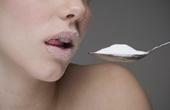The consumption of sugar in Russia

It is established that the long stay of sweets in the mouth is accompanied by an abundant release of so active enzyme - sucrose, that it destroys even slightly damaged tooth enamel, and this is the direct cause of caries. It is now found in industrialized countries in every 80-90 people out of a hundred. Recall caries - not only unpleasant sensations and even more unpleasant stay in the dentist's office, but this is also the spread of the so-called dental infection. Most caries is threatened by those who have soft food in their diets and who are fond of candy and toffee.
About half of the XVII century in Russia, almost no pure sugar. Tea and some food, and not every day, were sweetened with molasses from apples, pears, watermelons, melons, carrots. Since the end of the XVII century in large cities of Russia begin to periodically deliver raw sugar from a special cane or just sugar cane. In 1718 merchant Vestov, with the direct support of Peter I, built a special factory for processing this raw material, which was located on the Vyborg side of Petersburg. But even after that, sugar for a long time was still scarce and scarce. Many did not consume it, because there was an opinion: "Sugar is a sin: it is passed through canine bones and blood."Indeed, raw sugar has been used to purify sugar, and even now there are some uses of bone meal, bone char and blood of slaughter cattle. Therefore, it was not by chance that such sugar was called long-term sugar, in contrast to lean home-made sugar.
Since 1802 Russia is one of the first in Europe to start producing sugar from domestic raw materials - sugar beets. And pretty soon he ceased to be only a delicacy for the elect. When the tsarist government in 1902 introduced a "tea tax" on tea and sugar, the reaction of the progressive public of Russia turned out to be very harsh. A glass of tea with sugar and bread by then was already almost indispensable food for many families.
With striking perseverance, a man was seeking more and more purification of many food products, including sugar, which at first was a brown powder. In remote "extraneous" impurities were biologically active substances, very useful to the human body. For example, in refined sugar there is practically no chrome! And this microelement, as is known, participates in the exchange of insulin, it helps prevent certain heart diseases and myopia. A well-known pharmacologist and toxicologist, Professor II Brekhman, studied the effect of not completely purified sugar, which is not yellow, but white. Unlike refined sugar, it did not contribute to the formation of fat-protein substances - low-density lipoproteins, which are one of the causes of the development of atherosclerosis of blood vessels. Moreover, when replacing refined sugar with sugar, not completely purified, high-density lipoproteins accumulate in the blood, which have a certain ability to restrain the development of this formidable disease.
